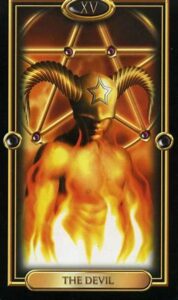The Three of Swords and Devil Tarot Card Combination. In the realm of Tarot, every card carries its own unique story, weaving together threads of wisdom and insight into the human experience. Among the myriad combinations that grace the Tarot deck, the pairing of the Three of Swords and the Devil stands as a poignant fusion of heartbreak, temptation, and the shadow aspects of pain. In this article, we delve into the symbolism and wisdom encapsulated within the synergy of these two potent cards, exploring themes of healing, liberation, and the journey towards self-empowerment in the face of adversity.
The three of Swords:
The Three of Swords embodies themes of heartbreak, sorrow, and emotional pain. Depicted as three swords piercing a heart, the card symbolizes the anguish that arises from loss, betrayal, and separation.
Key themes associated with the Three of Swords Tarot Card:
Heartbreak and Sorrow: At its core, the Three of Swords represents heartbreak and sorrow. It signifies the pain that arises from loss, betrayal, and separation, and the deep emotional wounds that we carry with us as a result.
Grief and Loss: The imagery of the Three of Swords with its swords piercing a heart suggests a sense of grief and loss. It symbolizes the anguish that comes from experiencing the end of a relationship or the betrayal of trust, and the mourning process that follows.
Emotional Healing: Despite its somber imagery, the Three of Swords also carries the potential for emotional healing and growth. It reminds us that through facing our pain and allowing ourselves to grieve, we can begin the process of healing and transformation.
The Devil:
In contrast to the sorrow of the Three of Swords, the Devil embodies themes of temptation, bondage, and the shadow aspects of desire. Depicted as a figure chained to a pedestal, with chains around its neck and the necks of two figures, the card symbolizes the grip of materialism and the chains that bind us to our earthly desires.
Key themes associated with the Devil Tarot card:
Temptation and Bondage: At its essence, the Devil represents temptation and bondage. It signifies the allure of material pleasures and the ways in which we can become ensnared by our desires.
Addiction and Obsession: The imagery of the Devil with its chains and bondage suggests a sense of addiction and obsession. It symbolizes the ways in which we may become enslaved by our desires and lose sight of our true values and priorities.
Release and Liberation: Despite its ominous imagery, the Devil also carries the potential for release and liberation. It reminds us that we have the power to break free from the chains that bind us and reclaim our sovereignty.
The Combination of the Three of Swords and the Devil:
When the Three of Swords and the Devil appear together in a Tarot reading, their combined energies create a potent synergy, offering profound insights into the nature of heartbreak, temptation, and the journey towards healing and liberation.
Confronting Painful Truths: The Three of Swords represents heartbreak and sorrow, while the Devil symbolizes the temptation to indulge in excess and lose sight of our true values. When these two cards appear together, they suggest that true healing requires us to confront painful truths and acknowledge the ways in which we may be allowing ourselves to be controlled by our desires. The Three of Swords invites us to face our pain and allow ourselves to grieve, while the Devil reminds us to be mindful of the ways in which we may be seeking solace in unhealthy coping mechanisms. Together, they invite us to embrace the process of healing and transformation that comes from releasing ourselves from the grip of materialism and embracing a life of authenticity and freedom.
Finding Liberation through Acceptance: The Three of Swords represents the process of emotional healing and growth, while the Devil symbolizes the bondage of addiction and obsession. When these two cards appear together, they suggest that true liberation comes from accepting our pain and allowing ourselves to be vulnerable. The Three of Swords invites us to honor our emotions and embrace the process of healing and transformation, while the Devil reminds us that true freedom comes from releasing ourselves from the chains that bind us to our earthly desires. Together, they invite us to embrace the journey towards self-empowerment and liberation, knowing that true healing comes from accepting ourselves fully and embracing the beauty of our own vulnerability.
Embracing Self-Compassion: The Three of Swords represents the need for self-compassion and self-care in times of pain and sorrow, while the Devil symbolizes the importance of breaking free from the grip of self-destructive habits and behaviors. When these two cards appear together, they suggest that true healing requires us to embrace self-compassion and release ourselves from the cycle of self-blame and judgment. The Three of Swords invites us to honor our emotions and allow ourselves to grieve, while the Devil reminds us to be gentle with ourselves and recognize that we are worthy of love and compassion, even in our darkest moments. Together, they invite us to embrace the journey towards self-acceptance and self-love, knowing that true healing comes from embracing ourselves fully and embracing the beauty of our own vulnerability.
Conclusion:
The combination of the Three of Swords and the Devil in a Tarot reading offers a powerful invitation to explore the journey towards healing and liberation in the face of adversity. It reminds us that true healing requires us to confront painful truths, embrace our vulnerability, and release ourselves from the grip of self-destructive habits and behaviors. As we navigate the complexities of life’s journey, may we draw upon the wisdom of Tarot to guide us towards greater understanding, healing, and self-empowerment.

I’m Erin. I’m an artist, designer, author and entrepreneur. I’m also a mom, feminist, volunteer and activist. Some of things that light me up are textiles, theology, alien theory, comic book art, live music, travel and learning. I am constantly evolving as a creative and a human.

